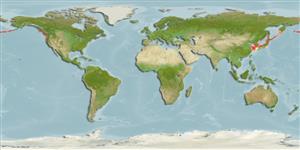Preferred temperature (Ref.
115969): 11.9 - 23, mean 19.1 (based on 74 cells).
Phylogenetic diversity index (Ref.
82804): PD
50 = 0.5156 [Uniqueness, from 0.5 = low to 2.0 = high].
Bayesian length-weight: a=0.01000 (0.00524 - 0.01907), b=3.23 (3.06 - 3.40), in cm Total Length, based on LWR estimates for this species & Genus-body shape (Ref.
93245).
Trophic level (Ref.
69278): 3.1 ±0.1 se; based on size and trophs of closest relatives
Widerstandsfähigkeit (Ref.
120179): hoch, Verdopplung der Population dauert weniger als 15 Monate. (K=0.6).
Prior r = 0.79, 95% CL = 0.52 - 1.18, Based on 4 data-limited stock assessments.
Fishing Vulnerability (Ref.
59153): Low vulnerability (14 of 100).
Climate Vulnerability (Ref.
125649): Low vulnerability (17 of 100).
